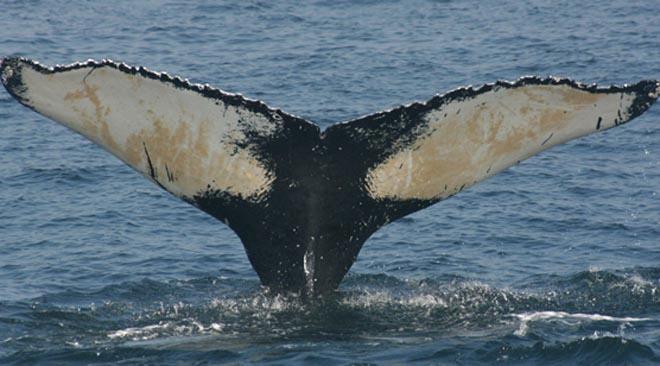Whale Tails- How Caribbean sailors can help whale research
by Nathalie Ward on 18 Jan 2014

This is ’Salt’ - her ’fingerprint’ tail long tracked by researchers in the Caribbean SW
Sailors for the Sea, a David Rockefeller project, whose mission it is to 'educate and engage the boating community in the worldwide protection of the oceans', occasionally publishes essays about the state of our oceans, the dangers, the beauty and the current issues. Here is their latest:
An International Citizen Science Project for Boaters:
The sea is slate-colored, smooth as asphalt. The wind isn’t howling, but speaking in a firm voice—a day like so many in the blue latitudes, perfect and unending. I’m on deck, barely awake—as I slowly take in the sense that my horizon is suddenly changing shape.
A humpback whale bursts through the surface like a locomotive from a tunnel. Some 100 yards from the boat, plumes of mist erupt from the sea, but it’s the harshness of its breathing—those explosive chuffs—that startles me most. — N. Ward
Anyone who sees a humpback is impressed by its enormity and grace. The size of a city bus, it rises from the sea firing vaporous plumes from its blowholes, and then slowly rolls into the depths, exposing a tiny dorsal fin on top of a small hump. A parting view may be a pair of 15-feet wide tail flukes raised over the water like the outstretched wings of a massive seabird.
Celebrated by Herman Melville as the most 'gamesome' of the great whales, theirs is a leisure society that predates ours by some 50 million years. Besides looking for food and feeding in northern latitudes, humpbacks spend their time in the winter months in the warm, tropical seas of the Caribbean—swimming, cavorting, conversing, wooing the opposite sex and giving birth and nursing their young.
A Sanctuary Concern—Protection Beyond Borders :
Within the animal kingdom, the humpback whale makes one of the longest migrations of any animal. They are international citizens—acknowledging no sovereignty but their own—traveling through international waters of the North Atlantic Ocean and the Caribbean Sea without a passport.
NOAA’s Stellwagen Bank National Marine Sanctuary, within the Gulf of Maine, protects a shared population of almost 1,000 humpback whales that return from their tropical breeding grounds with new calves each spring. This population shows a slowed recovery rate as human impacts such as entanglement in fishing gear and vessel strikes contribute to mortality throughout their migratory path.
In 2007, Stellwagen Bank National Marine Sanctuary created the Sister Sanctuary Program to develop strategic, science-based 'sister sanctuary relationships'—with other marine mammal sanctuaries in Bermuda, the Dominican Republic and French and Dutch Antilles—to insure the protection of humpback whales outside of U.S. borders, with specific focus on international breeding and mating grounds in the Caribbean and along migration corridors.
What A Tail Can Tell — Photo-Identification:
Knowing the identity of individual whales can be of critical importance to researchers. Photo-identification is a technique that enables scientists to identify an individual whale anywhere it may travel throughout its life by comparing black and white pigmentation patterns on the underside (or ventral portion) of the flukes, the two wings of the tail. These marking include both natural pigmentation and scars.
Using photo-identification techniques to help monitor the recovery of this endangered species, CARIB Tails is enlisting boaters as citizen scientists to help track the movements of humpback whales between their North Atlantic feeding grounds and their breeding grounds in the Wider Caribbean Region. The project is an international research collaboration between NOAA’s Stellwagen Bank National Marine Sanctuary, UNEP’s Caribbean Environment Programme’s Specially Protected Areas and Wildlife’s Programme and our conservation partners.
Since the early 1970s, humpback whales in Stellwagen Bank Sanctuary and elsewhere in the Gulf of Maine have been catalogued, not only with formal identification numbers, but also with names. By cataloguing individual humpback whales, scientists can monitor individual animals and gather valuable information about population sizes and migration patterns.
The Fluke Catalogue — The How and Why:
When new photographs of humpback tail flukes are received, they are matched against the photographs in the existing North Atlantic Humpback Whale Catalogue, which has been maintained since 1976 by Allied Whale at the College of the Atlantic, Bar Harbor, Maine USA. Information about each whale sighting (such as date, time, location) is kept in a database, or Catalogue. Using these kinds of data, it has been possible to learn that humpbacks mature no earlier than four years of age, may have calves every two years, travel to the Caribbean in winter to mate and give birth, and appear to return to the same northern feeding area each summer.
The Catalogue contains fluke photographs of more than 7,000 individual humpback whales. It is the result of collaboration between scientists, naturalists, citizen scientists and tourists who have contributed photographs of humpbacks from regions including North America, Norway, Iceland, Greenland and the Caribbean. Information gained from the Catalogue helps advance understanding of marine mammal conservation and habitat protection, raise public awareness, and motivate marine mammal conservation action and stewardship.
P.S. 'Salt', also known as the 'Grand Dame' of the Sister Sanctuary Program, has been seen on Stellwagen Bank Sanctuary every summer except one since 1976. She is also the first Gulf of Maine humpback whale to have been seen by researchers on Silver Bank off the Dominican Republic. Her sighting confirmed the north-south migration route of humpback whales.
WANTED: Your help tracking humpback whale migration with your photographs of humpback flukes:
If you get see a humpback whale while cruising in the Caribbean, you will never forget it. If you take a good photo of its flukes, you can contribute to the conservation of this spectacular animal. For more information about how you can participate visit: www.caribtails.org.
If you want to link to this article then please use this URL: www.sail-world.com/118471